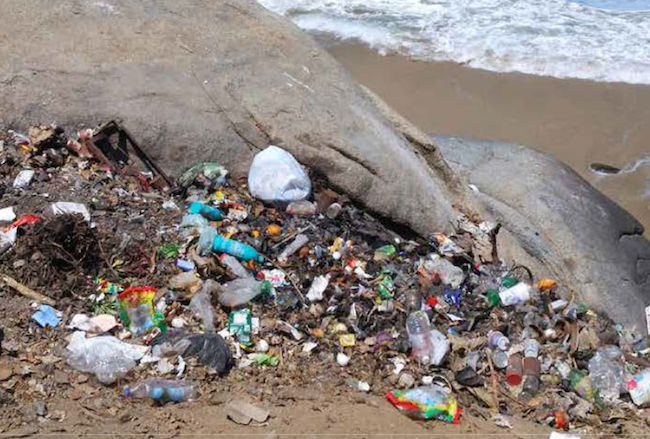
The quest for the sustainable hydrogen economy of the future is getting more complicated by the minute, as more evidence emerges about the role of natural gas in global warming. What's the connection? Well, hydrogen is an abundant, zero emission fuel. The problem is that hydrogen does not exist on its own. It must be extracted from something, and currently that something is, primarily, natural gas.
The good news is that the current state of affairs is beginning to give way to a new generation of sustainable hydrogen. With that in mind, let's take a look at Wales University of Swansea, which has come up with a sustainable solution that could help solve part of the ocean plastic problem, too.
The sustainable hydrogen twofer
Somewhat ironically, natural gas has been touted as a cleaner alternative to coal and petroleum. However, the climate change bloom is off that rose. The powerful greenhouse gas methane is the main constituent of natural gas, and it leaks all over the supply chain -- from drilling sites to pipelines, storage facilities and local distribution networks.
The climate change issue is over and above the local impacts of natural gas extraction, including air pollution and water resource impacts, and even earthquakes.
A good deal of the sustainable hydrogen research deals with electrolysis, in which an electrical current "splits" hydrogen from water (think H - two- O and you're on the right track). That's an energy intensive solution and it would have been uneconomical just a few years ago. With the advent of low cost wind and solar power, though, water splitting is becoming a practical solution to the natural gas problem.
Solar energy can also be used to power a photoelectrochemical reaction in water to produce hydrogen.
Most water splitting is based on using pure water, but an interesting environmental two-for-one is beginning to crop up. Researchers are beginning to develop systems that can produce sustainable hydrogen from polluted water and seawater.
In other words, hydrogen production could be used to offset the cost of water purification.
The Swansea solution
That brings us to the new Swansea research (let's tip our hats to our friends over at wardsauto.com, by the way).
Researchers in the school's chemistry department have developed a system that is similar to the photoelectrochemical pathway, except that it involves plastic instead of water.
The idea is to add a light-absorbing material to plastic, then soak it in an alkaline solution. Once exposed to sunlight, the plastic releases hydrogen.
As for a sustainable hydrogen twofer, according to the researchers any kind of plastic could be used, regardless of how dirty it is. In that case, hydrogen production could add value to plastic recycling, while also making the whole recycling chain more simple -- and less expensive -- to manage.
Interestingly, the researchers claim that small amounts of food waste seem to make the reaction more efficient.
As an additional bonus, the process only uses up about half of the plastic. The rest could be recycled to make other products.
Now, think one step ahead to the ocean plastic problem and you can see where this could go.
One major issue bedeviling ocean cleanup is cost. If any significant value could be recovered from ocean plastic, that would incentivize cleanup and prevention, too.
Don't hold your breath for plastic-to-hydrogen . . .
As may be expected, the Swansea research is years away from commercial application. The good news is that major hydrogen stakeholders are transitioning to sustainable hydrogen through other pathways.
India-based Business Industry Reports has just come out with a new analysis that forecasts surging growth in the global hydrogen market between 2018 and 2022. The top three companies in their list of major hydrogen producers are all engaged in sustainable hydrogen: Air Liquide, Air Products and Chemicals, and Hydrogenics.
Just to show how complicated the sustainability picture is becoming, though, a main source of demand for hydrogen has been in the petrochemical field, which still relies heavily on steam methane reforming from natural gas:
...The technology is employed in numerous applications such as chemical and pharmaceutical manufacturing, hydrogenation of oil, and petroleum refining, among others. Steam methane reforming is a mature technology and is widely adopted in these industries due to its higher efficiency when compared to other processes.
In particular, the report anticipates rising demand in several Middle East countries, due to demand for hydrogen related to low sulfur diesel produciton.
In other words, replacing natural gas with sustainable hydrogen could simply make it more economical to refine petroleum products.
Meanwhile, the firm ResearchAndMarkets.com is anticipating rapid growth in the hydrogen fuel cell electric vehicle market, so hold on to your hats.
Here in the US, the Department of Energy firmly behind renewable solutions for hydrogen vehicles, and private sector companies -- notably Ryder, Anheuser-Busch and the startup Nikola -- are already looking at renewable energy to provide hydrogen for long-haul fuel cell trucks.
Photo (screenshot): US Environmental Protection Agency.

Tina writes frequently for TriplePundit and other websites, with a focus on military, government and corporate sustainability, clean tech research and emerging energy technologies. She is a former Deputy Director of Public Affairs of the New York City Department of Environmental Protection, and author of books and articles on recycling and other conservation themes.














